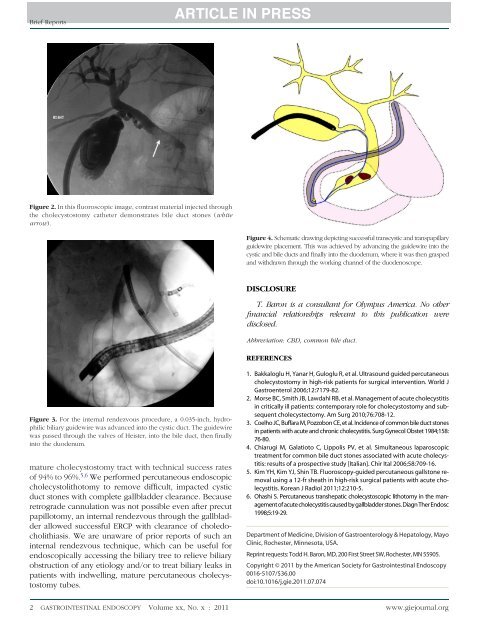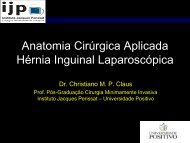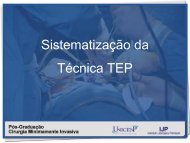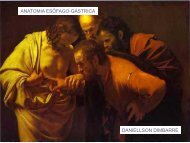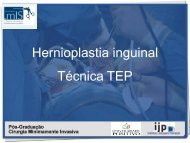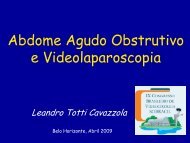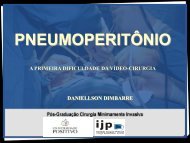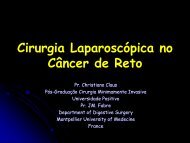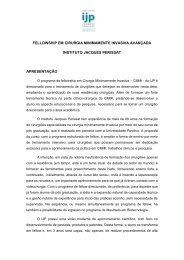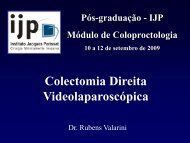Percutaneous cholecystoscopy and internal rendezvous for ... - IJP
Percutaneous cholecystoscopy and internal rendezvous for ... - IJP
Percutaneous cholecystoscopy and internal rendezvous for ... - IJP
Create successful ePaper yourself
Turn your PDF publications into a flip-book with our unique Google optimized e-Paper software.
Brief Reports<br />
Figure 2. In this fluoroscopic image, contrast material injected through<br />
the cholecystostomy catheter demonstrates bile duct stones (white<br />
arrow).<br />
Figure 4. Schematic drawing depicting successful transcystic <strong>and</strong> transpapillary<br />
guidewire placement. This was achieved by advancing the guidewire into the<br />
cystic <strong>and</strong> bile ducts <strong>and</strong> finally into the duodenum, where it was then grasped<br />
<strong>and</strong> withdrawn through the working channel of the duodenoscope.<br />
DISCLOSURE<br />
T. Baron is a consultant <strong>for</strong> Olympus America. No other<br />
financial relationships relevant to this publication were<br />
disclosed.<br />
Abbreviation: CBD, common bile duct.<br />
REFERENCES<br />
Figure 3. For the <strong>internal</strong> <strong>rendezvous</strong> procedure, a 0.035-inch, hydrophilic<br />
biliary guidewire was advanced into the cystic duct. The guidewire<br />
was passed through the valves of Heister, into the bile duct, then finally<br />
into the duodenum.<br />
mature cholecystostomy tract with technical success rates<br />
of 94% to 96%. 5,6 We per<strong>for</strong>med percutaneous endoscopic<br />
cholecystolithotomy to remove difficult, impacted cystic<br />
duct stones with complete gallbladder clearance. Because<br />
retrograde cannulation was not possible even after precut<br />
papillotomy, an <strong>internal</strong> <strong>rendezvous</strong> through the gallbladder<br />
allowed successful ERCP with clearance of choledocholithiasis.<br />
We are unaware of prior reports of such an<br />
<strong>internal</strong> <strong>rendezvous</strong> technique, which can be useful <strong>for</strong><br />
endoscopically accessing the biliary tree to relieve biliary<br />
obstruction of any etiology <strong>and</strong>/or to treat biliary leaks in<br />
patients with indwelling, mature percutaneous cholecystostomy<br />
tubes.<br />
1. Bakkaloglu H, Yanar H, Guloglu R, et al. Ultrasound guided percutaneous<br />
cholecystostomy in high-risk patients <strong>for</strong> surgical intervention. World J<br />
Gastroenterol 2006;12:7179-82.<br />
2. Morse BC, Smith JB, Lawdahl RB, et al. Management of acute cholecystitis<br />
in critically ill patients: contemporary role <strong>for</strong> cholecystostomy <strong>and</strong> subsequent<br />
cholecystectomy. Am Surg 2010;76:708-12.<br />
3. Coelho JC, Buffara M, Pozzobon CE, et al. Incidence of common bile duct stones<br />
in patients with acute <strong>and</strong> chronic cholecystitis. Surg Gynecol Obstet 1984;158:<br />
76-80.<br />
4. Chiarugi M, Galatioto C, Lippolis PV, et al. Simultaneous laparoscopic<br />
treatment <strong>for</strong> common bile duct stones associated with acute cholecystitis:<br />
results of a prospective study [Italian]. Chir Ital 2006;58:709-16.<br />
5. Kim YH, Kim YJ, Shin TB. Fluoroscopy-guided percutaneous gallstone removal<br />
using a 12-fr sheath in high-risk surgical patients with acute cholecystitis.<br />
Korean J Radiol 2011;12:210-5.<br />
6. Ohashi S. <strong>Percutaneous</strong> transhepatic cholecystoscopic lithotomy in the managementofacutecholecystitiscausedbygallbladderstones.DiagnTherEndosc<br />
1998;5:19-29.<br />
Department of Medicine, Division of Gastroenterology & Hepatology, Mayo<br />
Clinic, Rochester, Minnesota, USA.<br />
Reprint requests: Todd H. Baron, MD, 200 First Street SW, Rochester, MN 55905.<br />
Copyright © 2011 by the American Society <strong>for</strong> Gastrointestinal Endoscopy<br />
0016-5107/$36.00<br />
doi:10.1016/j.gie.2011.07.074<br />
2 GASTROINTESTINAL ENDOSCOPY Volume xx, No. x : 2011 www.giejournal.org


